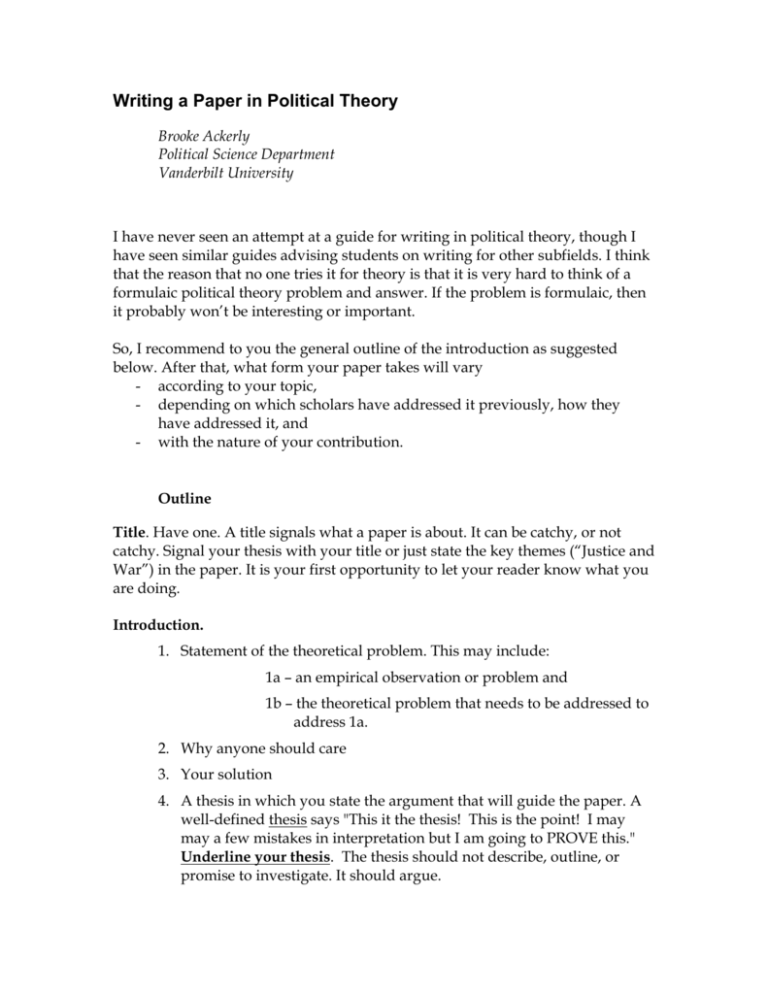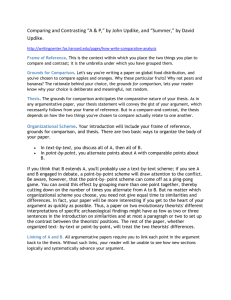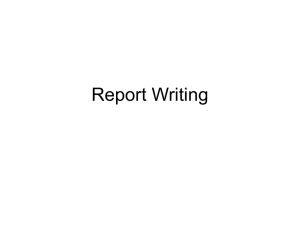Writing a paper in Political Theory
advertisement

Writing a Paper in Political Theory Brooke Ackerly Political Science Department Vanderbilt University I have never seen an attempt at a guide for writing in political theory, though I have seen similar guides advising students on writing for other subfields. I think that the reason that no one tries it for theory is that it is very hard to think of a formulaic political theory problem and answer. If the problem is formulaic, then it probably won’t be interesting or important. So, I recommend to you the general outline of the introduction as suggested below. After that, what form your paper takes will vary - according to your topic, - depending on which scholars have addressed it previously, how they have addressed it, and - with the nature of your contribution. Outline Title. Have one. A title signals what a paper is about. It can be catchy, or not catchy. Signal your thesis with your title or just state the key themes (“Justice and War”) in the paper. It is your first opportunity to let your reader know what you are doing. Introduction. 1. Statement of the theoretical problem. This may include: 1a – an empirical observation or problem and 1b – the theoretical problem that needs to be addressed to address 1a. 2. Why anyone should care 3. Your solution 4. A thesis in which you state the argument that will guide the paper. A well-defined thesis says "This it the thesis! This is the point! I may may a few mistakes in interpretation but I am going to PROVE this." Underline your thesis. The thesis should not describe, outline, or promise to investigate. It should argue. 5. A roadmap of the paper. End your introduction with a paragraph that tells the reader how the paper will proceed. Every section of the paper should be clearly delineated by content (and subheadings) so that it is clear which part of the “road” we are on. Body. This contains multiple sections. These do not need to be delineated by headings, but they should be clear to author and reader. They should correspond to the parts of the argument necessary to prove the thesis and they should correspond to the outline given in the roadmap. A. Description of the problem (there are two types) The first section of the paper should set up the problem. 1. The problem may be a problem in real life that political theory needs to address or can address well. (type 1 problem) 2. The problem may be a problem in political theory that political theory needs to address. (type 2 problem) 1. If you have a paper with a type 1 problem (a problem in life for theory), your problem section may take up two sections: Exposition of the problem Literature review of those who have looked at the problem in other fields – be sure to seek out competing views of the problem. Your empirical contribution if any. Exposition of the problem for theory Critical discussion of relevant literature (Look high and low for those who have dealt with a related problem.) What do these theorists say? What do you make of it? Do not conflate both kinds of discussions. 2. If you have a paper with a type 2 problem (a problem in theory for theory), your problem section will likely be one section, but it may also be broken into subsections each that sets out a different part of the problem. Exposition of the problem for theory Critical discussion of relevant literature (Look high and low for those who have dealt with a related problem.) What do these theorists say? What do you make of it? Do not conflate both kinds of discussions. What literatures are you considering? Have your questions been asked (and answered) by other theorists? What does the full terrain of the field look like? Within a context of the full terrain, you may choose to explain the views of only certain theorists. You must give reasons for these choices. You may decide that a theorist or group of theorists has a coherent argument but that they have never pulled together the pieces of that argument and you do that for them. Or maybe you have seen that a theorist has changed her view on a topic, or that she has been indecisive. B. Your contribution Your contribution depends on your exposition of the problem and the problem for theory and if it was ridiculous of me to try to offer an outline for a theory paper up to this point, it is even more so at this point. Your contribution might be methodological. Perhaps you have noticed that other theorists have made certain assumptions about … Your contribution might be a new way of thinking about an otherwise familiar topic. Perhaps you notice the theoretical content of a seemingly non-theoretical issue. Perhaps you see a new application of an otherwise familiar way of thinking (O’Neill 2000). Your contribution might be conceptual (White 2000). Perhaps you notice a common ground among thinkers whom others would see as irreconcilable. Conclusion. Restate the problem. Restate why anyone should care. Restate your solution/contribution. You may restate the argument briefly, but you will also want to describe your contribution as methodological, conceptual… More general advice The writing This is not an aside, but rather essential to all of the above: You must write clearly. Ideas of a complex nature are at stake in a political theory paper. You must be careful in your word choices and clear in your grammar. Commas change meaning. Where you put “only” affects meaning. Some theorists have the capacity to draw you in and you start using their jargon, their turns of phrase, and their sentence structures as you discuss their ideas. You are on your way to becoming a theorist. You must find your own voice and it is an important professional choice. I strongly urge you to choose to write in a way that is accessible to a broad audience with wide-ranging theoretical sympathies. The craft of writing is important in political theory. The pitch Ultimately, you are selling your reader on an idea (and on you as its author). The paper must proceed as if holding the reader by the collar (or the arm or the hand, depending on the touch you are looking for), but don’t let the reader get away during the argument. Each part of the argument should be explicit about 1) its role with regard to the whole and 2) the point being made. Theory articles and papers can take between two and six hours to read. Therefore, you need to consider that your reader may be interrupted in her reading and you should organize your paper with clear sections as building blocks so that the reader can return to the paper and regain the argument without too much rereading. The project Now here is the more personal part. As a graduate student (and even more so as a career academic), you have lots of demands on your time. As brilliant as you are or will be you will never finish everything if you don’t plan to finish. My personal motto, “focus and finish,” comes from my last nine months in residence at Stanford when I was teaching, taking courses, took a field exam, finished a field paper, and finalized my dissertation proposal. If I didn’t get these things done, I would not have been able to spend the next year at Yale (or live with my partner). Not only do you need a plan for how you are going to get all of your projects done, but because of the interruptions and in order to be thorough, you need a plan for each project. In Bird by bird: some instructions on writing and life, Anne Lamott (1994) shares the advice that her father gave to her brother. Little brother had to write a long report on birds and he would not be able to have any fun until he finished. The father said, just proceed “bird by bird.” Parse your project and deal with each part in a focussed way. Certainly the parts are connected. Take notes that enable you to capture these connections. But do not allow the connections and tangents to distract you from the project at hand. Perhaps as a result of your research on part I, you find that you need to reorganize the paper. Good, stop working on part I and reorganize. Then redefine the parts, rewrite the abstract of the project, and then focus again on each part successively. Keep control over what part of your project you are working on. Big projects, worthy projects, take a long time – time to read and time to reflect. That time is an important investment. “Focus and finish” and “bird by bird” are not mottos for rushing the process. My personal symbol is the turtle. Slow, not for the sake of slow, but slow that yields steady progress. Real substantive theoretical insights may be born in an instant, but the pre-germination process of laying the groundwork for them to come is long and the post-germination process of developing them to the point where they should be shared with a larger audience is long as well. While you are plodding along at a turtle’s pace, you are making progress. You cannot skip the work done at the turtle’s pace.







